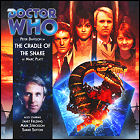 With the Mara once again forcefully asserting its dominance over Tegan’s personality, the Doctor tries to go into his companion’s mind to excise the evil influence once and for all. But the Doctor’s best intentions have even worse results: the Mara takes over his mind instead. The Doctor, under the Mara’s influence, pilots the TARDIS to Manussa, the homeworld of the Mara’s empire… over a century before that empire will come into being. While Tegan is found to be free of the Mara’s influence, the possessed Doctor is working behind the scenes to ensure that the Mara will hold thrall over the entire planet, using Manussa’s mass media as the vehicle for the Mara’s message. Slowly gathering allies and power, the Mara prepares to take over the minds of the Manussans, even if it rewrites history by bringing the Sumaran Empire about too early. In the meantime, Nyssa, Tegan and Turlough watch helplessly as the Doctor becomes an agent of evil, leaving it to them to save Manussa.
With the Mara once again forcefully asserting its dominance over Tegan’s personality, the Doctor tries to go into his companion’s mind to excise the evil influence once and for all. But the Doctor’s best intentions have even worse results: the Mara takes over his mind instead. The Doctor, under the Mara’s influence, pilots the TARDIS to Manussa, the homeworld of the Mara’s empire… over a century before that empire will come into being. While Tegan is found to be free of the Mara’s influence, the possessed Doctor is working behind the scenes to ensure that the Mara will hold thrall over the entire planet, using Manussa’s mass media as the vehicle for the Mara’s message. Slowly gathering allies and power, the Mara prepares to take over the minds of the Manussans, even if it rewrites history by bringing the Sumaran Empire about too early. In the meantime, Nyssa, Tegan and Turlough watch helplessly as the Doctor becomes an agent of evil, leaving it to them to save Manussa.
written by Stephen Cole
directed by Barnaby Edwards
music by Richard Fox & Lauren YasonCast: Peter Davison (The Doctor), Janet Fielding (Tegan Jovanka), Sarah Sutton (Nyssa), Mark Strickson (Turlough), Dan Stevens (Rick ausGarten), Hugh Fraser (Dr. Hanri Kerrem), Madeleine Potter (Yoanna Rayluss), Vernon Dobtcheff (Dada Desaka), Toby Sawyer (Baalaka)
Timeline: for the Doctor, Tegan and Turlough: between Enlightenment and The King’s Demons; for Nyssa: 50 years after Terminus. This story takes place after The Whispering Forest and before Heroes Of Sontar.
LogBook entry and TheatEar review by Earl Green
Review: The most continuity-bound story of this trilogy of stories, Cradle Of The Snake is also the most gripping thanks to a delightfully unhinged performance by Peter Davison. The notion of the Doctor possessed by evil made me groan a little bit at first – Zagreus isn’t a personal favorite – but Davison pulls it off and sounds like he’s having a hell of a lot of fun in the process. The other regulars, now tasked with being the heroes of the piece, rise to the occasion, with Janet Fielding and Mark Strickson coming across as particularly impressive. Refreshingly, despite numerous mentions of how easily led / influenced / dominated Turlough is, he’s the one member of the TARDIS crew who never falls under the Mara’s spell in the course of the story.
 The danger of unearthing the Mara mythology is that the previous two stories featuring the evil entity were both written by one very well-regarded writer who built both Kinda and Snakedance over a skeleton of Buddhist lore. There’s almost universal admiration of Kinda‘s surrealism, and while Snakedance is a bit more on-the-nose, it too is stranger than most Doctor Who fare of its day (and that’s saying something when it shared the same season as Enlightenment). By comparison, Cradle Of The Snake doesn’t even try to reach that level of complexity and subtext: there’s something almost simplistic about the Mara’s ability to take over its victims, and the story never really nails down how this happens. Kinda strongly implied that the Mara’s victims had to, in essence, give the entity permission to take them over, even if it meant they were coerced or manipulated into that union; Cradle seems to distribute Mara influence with free snake tattoos for everyone, confusing the established storyline a bit. Even dropping in a hint that the Doctor’s Gallifreyan telepathic abilities lent the Mara an unusual amount of power would’ve helped. As it is, the Mara becomes a stock take-over-anyone’s-mind baddie straight out of Star Trek: The Next Generation.
The danger of unearthing the Mara mythology is that the previous two stories featuring the evil entity were both written by one very well-regarded writer who built both Kinda and Snakedance over a skeleton of Buddhist lore. There’s almost universal admiration of Kinda‘s surrealism, and while Snakedance is a bit more on-the-nose, it too is stranger than most Doctor Who fare of its day (and that’s saying something when it shared the same season as Enlightenment). By comparison, Cradle Of The Snake doesn’t even try to reach that level of complexity and subtext: there’s something almost simplistic about the Mara’s ability to take over its victims, and the story never really nails down how this happens. Kinda strongly implied that the Mara’s victims had to, in essence, give the entity permission to take them over, even if it meant they were coerced or manipulated into that union; Cradle seems to distribute Mara influence with free snake tattoos for everyone, confusing the established storyline a bit. Even dropping in a hint that the Doctor’s Gallifreyan telepathic abilities lent the Mara an unusual amount of power would’ve helped. As it is, the Mara becomes a stock take-over-anyone’s-mind baddie straight out of Star Trek: The Next Generation.
One interesting aspect of Cradle is that it states, over and over, that the rise of the Mara that we see later (and its eventual exodus – or exile? – into space) happens in the future, which makes Cradle an interesting prequel which sets the stage for a civilization that will eventually surrender to the entity. (The fifth Doctor seems to get an awful lot of interesting “prequel” stories courtesy of Big Finish: see also Spare Parts and Primeval.) What’s really interesting is that “early” Manussa closely resembles present-day Earth, give or take some key bits of fictional technology. It draws on the common memory of somewhat recent pop culture too, with the event that leads to the Mara’s public unveiling resembling nothing so much as the controversial 1992 UK Ghostwatch broadcast, complete with public officials trying to shut the whole endeavour down.
And finally, it seems that the Tegan-Turlough-older Nyssa era isn’t over: the runaway plague carrier hasn’t been found, and the Doctor still seems to have a rough time flying the TARDIS (namely, coming to Manussa a century too early), so Nyssa is still unquestionably along for the ride (and, of course, so is the plague-infested survivor she’s pursuing with the Doctor’s help). But with the entire cast gamely recreating their distinctly ’80s characters – and apparently enjoying it – this isn’t a bad thing. One of the last things I ever expected, based on Big Finish’s past output, was a recreation of thee extremely crowded Davison-era TARDIS – and I certainly didn’t expect to enjoy it this much.

